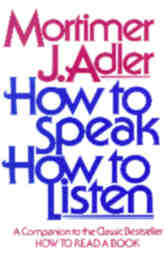One of the books I recommend most often to my students is Mortimer J. Adler’s classic How To Read A Book. Students who take up my challenge that despite being in graduate school they need to learn to read and so should study Adler’s helpful guide tend to do much better in their studies. In How to Speak and How to Listen (New York: Simon & Schuster, 1983) American philosopher Mortimer Adler offers the same service to oral communication as he did to the printed word. In this book he reviews keys to public speaking and to intentional listening in three sections framed by a prologue and epilogue. These sections encompass the process used in speaking and listening that Adler feels should be incorporated in every “heart-to-hear talk,†personal conversation, and public speeches.

In Part One Adler covers the social aspects of speaking and listening. By associating speaking and listening as constant social activities, Adler presents the idea that these skills are not taught, but instead he insists that these qualities are picked up the more a person is involved in any social activity. He defines the nature of conversation and communication and delineates the social aspects of each category.
In Part Two Adler introduces three forms of public speaking as well as the details involved in creating and giving a speech to an audience (whether they be captive of non-captive). Adler’s explication of the types of speech is very helpful: rhetoric speech, persuasive speech, and instructive speech. He defines rhetoric speech as an oratory style which is made without becoming intensively involved in the subject being considered. Persuasive speech encompasses the “feeling†the subject brings and combines three factors – ethos, pathos, and logos where the term logos (with logos containing taxis and lexis). Instructive speech, Adler insists, must be provided at a comfort level with the topic so that speech comes across in such a way that allows the audience to increase their knowledge in the subject.
Part Three of the book covers the art of silent listening as well as introducing the general styles of writing a speech. Adler offers the insight most teacher and preachers understand: namely, that in order to change the action of hearing into the art of listening the audience must put forth some effort in understanding the words of the speaker. He states that in order to be able to fully appreciate the art of speaking, listening is key. Listening is not observing the speaker and what he or she is saying and forming opinions immediately after the words are spoken. Rather, the art of listening involves actively trying to pull information out of the presentation and forming opinions after the speaker has had a chance to express her or his thoughts. The section on the art of writing is practical and will instantly make any delivery more effective if followed.
Parts four and five incorporate the questions-and-answers part of a speech as well as the aspects of live conversation. Adler presents the art of speaking and listening as parallels to the art of reading and writing. He establishes a comparison in that it takes effort on the part of the creator/hearer to truly understand the emphasis of the subject that is being conveyed. Adler was a prolific writer and one of the premier American philosophers. It is somehow gratifying that two of his most helpful—if not influential books would contain the pragmatic phrase “how to†in the titles. I think this may become one of the other most recommended books to my students.


Pingback: Book Reviews